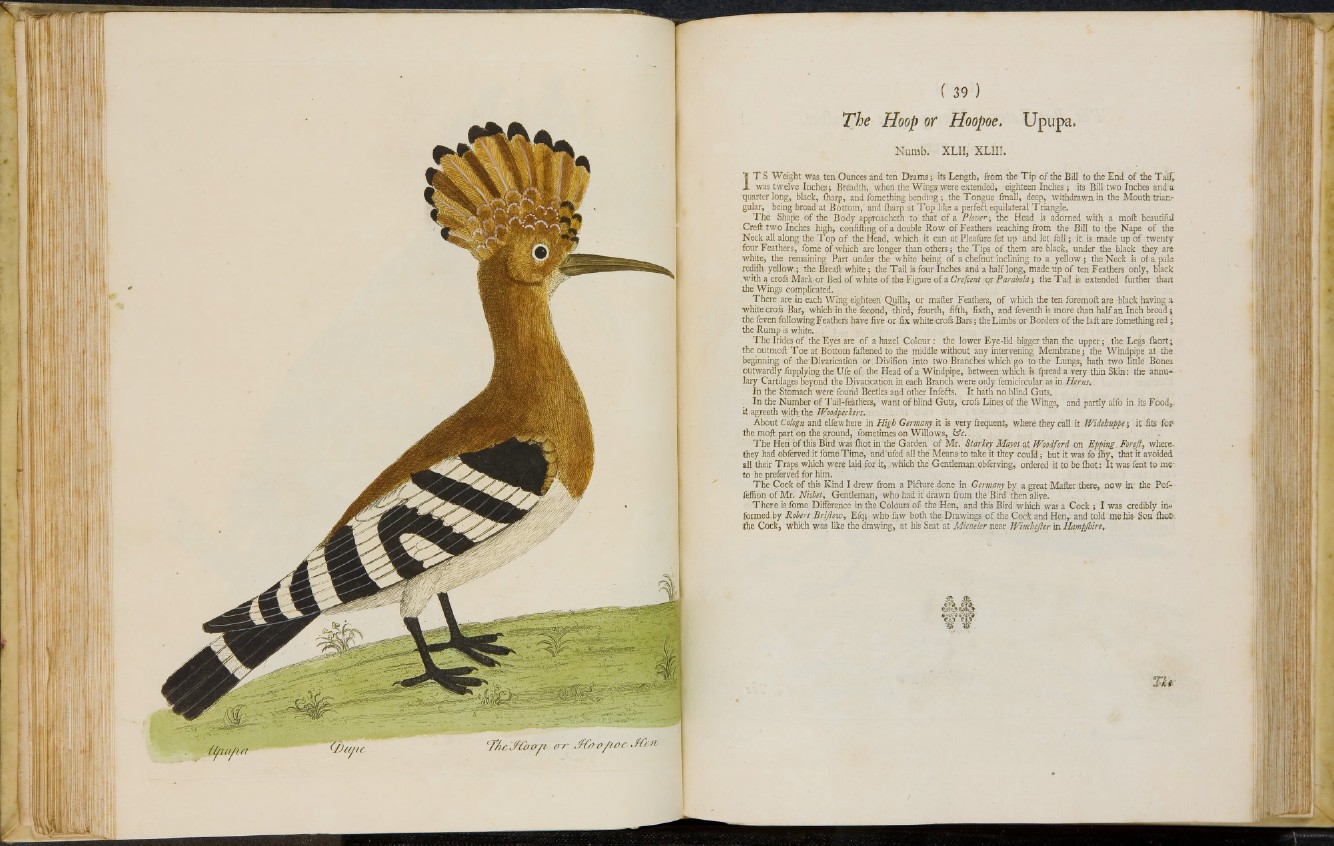
The Hoop or Hoopoe. Upupa.
Numb. XLII, XLIIL
IT S Weight was, ten Ounces and ten D ram s ; its Length, from the T ip o f the Bill to the End o f the T a iÇ
was twelve Inches; Breadth, when the Wing? were extended, eighteen Inches ; its B ill two Inches and a
quarter long, black, iharp, and fomething bending ; the To n gue fmall, deep, withdrawn in the Mouth trianr
gular, being broad at B ottom, and iharp at T o p like a perfect equilateral Triangle.
T h e Shape o f the B o d y approacheth to that o f a Plover ; the Head is adorned with a moft beautiful
Creft tw o Inches high, confifting o f a double R o w o f Feathers reaching from the B ill to the Nape o f the
Neck all along the T o p o f the Head, which it can at Pleafure fet up and let fall ; it is made up o f twenty
four Feathers,' fomë o f which are longer than others ; the T ip s o f them are black, under the black they are
white, the remaining Part under the white being o f a chefnut inclining to a yellow ; the Neck is of a pale
redifh yellow.; the Breaft white ; the T a i l is four Inches and a h a lf lon g , made up o f ten Feathers only, black
.with a crois Mark o r Bed o f white o f the Figure o f a Crefcent or Parabola ; the T a il is extended further than
the Wings complicated.
T h e re are in each W in g eighteen Quills, o r mailer Feathers, o f which the ten foremoft are black having a
white crois B ar , which in the fécond, third, fourth, fifth, fixth, and feventh is more than h alf an Inch broad ;
the feven following Feathers have five or fix white croîs Bars ; the Limbs or Borders o f the la fl are fomething red j
the Rump is white..
T h e Irides o f the E yes are o f a h azel Colour : the lower Eye -lid bigger than the upper; the Legs fh o rt;
the outmoft T o e at Bottom fattened to the middle without any intervening Membrane ; the Windpipe at the
beginning o f the Divarication or .Divifion into two Branches which go to the Lungs', hath two little Bones
outwardly fupplying the U fe of, the Head o f a Windpipe, between which is .fpread a very thin Skin : the annu-*
lary Cartilages beyond the Divarication in each Branch were only femicircular as in Herns».
In the Stomach were found Beetles and other Infedts. I t hath no blind Guts.
In the Number o f Tail-feathers, want o f blind Guts, croîs Lines o f the Wings, and partly alfo in its Foody
it agreeth with; the Woodpeckers»
About Cologn and elfe.where in High Germany it is very frequent, where they call it Widehuppe ; it fits for5
the moft p ar to n the ground, fometimes on W illow s , &c.. '
T h e Hen o f this Bird was fhot in the' Garden o f M r . Starkey May os a t Woodford on Epping^ForeJl, where-
they had oblérved i f fomë T im e , and'ufed all the* Means^to take it they could ; but it was fo fh y , that it avoided
all their Trap s which were laid for it, ; which the Gentleman, obferving, ordered it to be fhot: I t w as ferit to me*
to be prefèrved for him.
T h e C ock o f this Kind I drew from a Pidlure done in Germany by a great Matter there, n ow in1 the P o f-
feffion o f Mr. Nisbet, Gentleman, who had itr drawn from the Bird' then alive.
T h e r e is fome Difference irr the Colours o f the Hen, and this Bird which was a Cock ; I was credibly in*»
formed .by Robert Brijlow, E fq ; who faw both the; Drawings of, the Cock and Hen,, and told me his-Son fhot-:
¿he Cock , which was like the drawing, at his Seat at Micbeler near Wirtchejler in. Hampjhire»